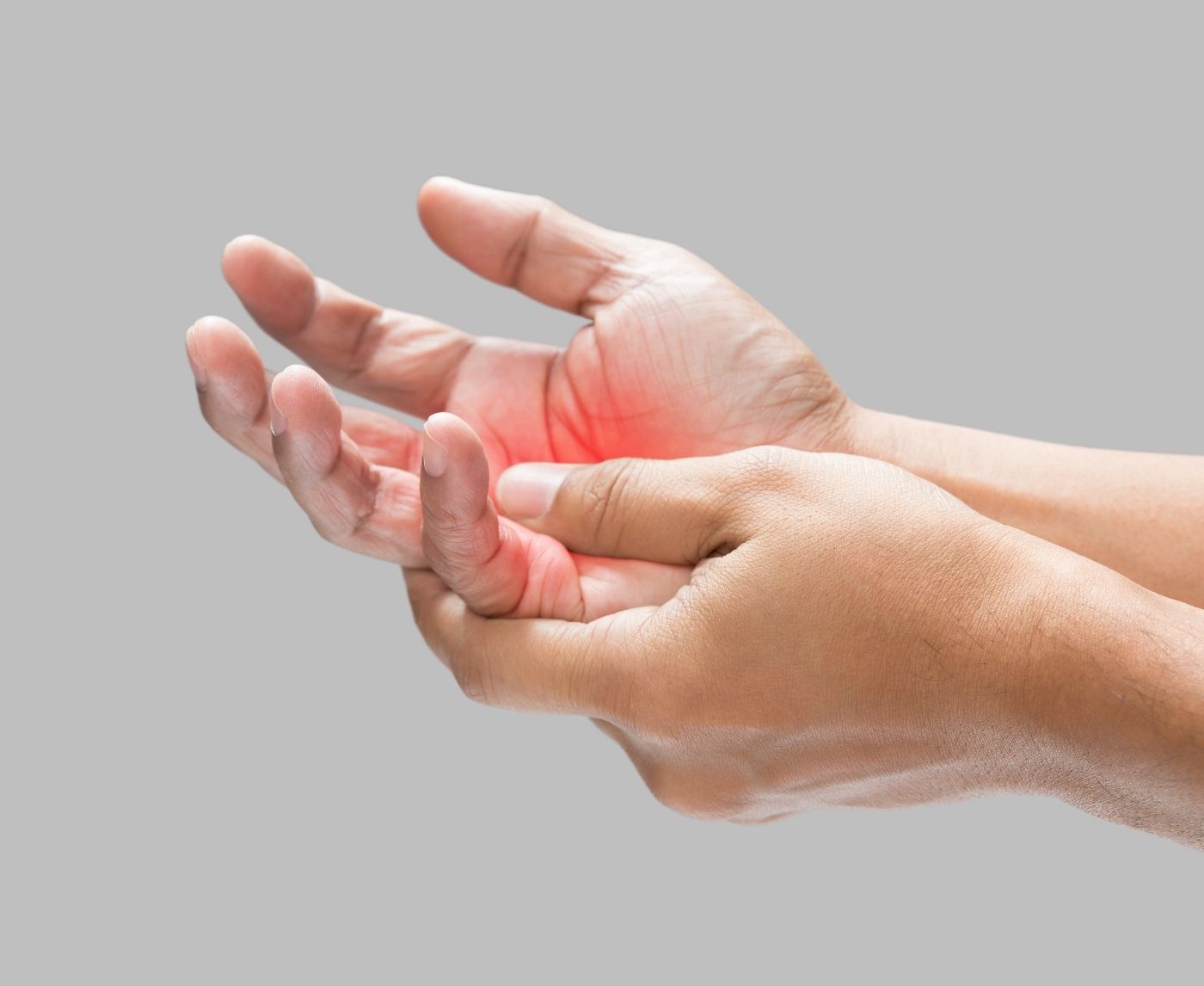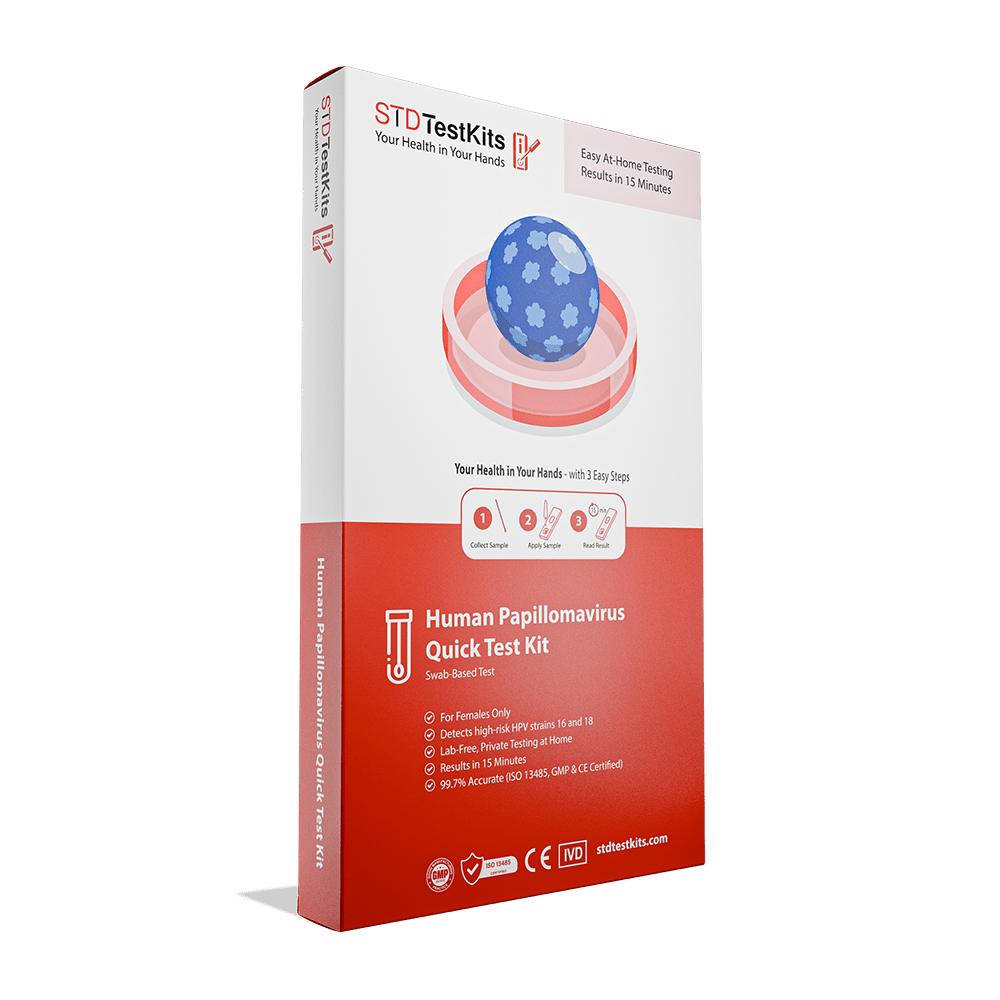No Symptoms, No Problem? Why You Still Might Need an STD Test
Quick Answer: Yes, some STDs can spread through contact between hands and genitals. This is especially true for Herpes, HPV, and sometimes Gonorrhea or Chlamydia if infected fluids get into small cuts or mucous membranes. There is a small chance of getting sick, but it is not zero. If you start to feel sick, you may want to get tested.
This article includes fictionalized perspectives meant for educational illustration. They are not direct patient accounts.
It started as a casual hookup, nothing “serious,” nothing that crossed the invisible line most people define as sex. Just hands. Just touch. When Alex woke up two days later with a burning spot on his fingertip and a red bump near his groin, he panicked. His first thought wasn’t infection; it was confusion. “How could this even happen?” he typed into his phone at 3 a.m., fingers trembling over the words ‘can you get an std from hands?’ The search results, contradictory and vague, only made his heart race faster.
What Alex felt in that moment, fear, disbelief, and shame, mirrors thousands of real searches every day. The idea that you can get an STD without intercourse still shocks people, but science and experience say it’s possible, even if rare. To understand why, we have to strip the myths away and talk plainly about how infections actually move from body to body.

People are also reading: Foreplay Isn’t Risk-Free How STDs Can Spread Without Sex
Why Hands Aren’t Always “Safe Enough”
For decades, sex education simplified sexual risk into a neat binary: intercourse equals danger; everything else is safe. But skin doesn’t follow those social rules. Human hands are porous with microscopic breaks, hangnails, and nail beds that act like tiny doors for viruses and bacteria. Most of the time, those doors stay closed. Sometimes, under the right conditions, warmth, friction, fluid exchange, they open just enough for transmission to occur.
What scientists call “manual sex” includes everything from fingering to mutual masturbation. It feels physically distant from what we label “sex,” yet it can still involve contact with semen, vaginal fluids, or genital skin that carries viral particles. According to the Centers for Disease Control and Prevention (CDC), infections such as Herpes simplex virus (HSV-1 and HSV-2) and Human papillomavirus (HPV) can spread via direct skin contact, no penetration required. That’s what makes these infections so frustratingly persistent: they don’t always need friction or fluid; sometimes, skin is enough.
It’s also how Herpetic Whitlow, herpes on the finger, happens. A small cut or hangnail touches an infected partner’s genitals or mouth, and the virus finds its way in. While this is rare, it’s medically documented and more common among healthcare workers or sexually active individuals who engage in manual play without barriers.
The Science of “Low Risk” Isn’t “No Risk”
Let's get this straight right away: most people will never get an STD from a hand job or fingering. The risk is much lower than with oral, vaginal, or anal sex. But "low" does not mean "zero," and not getting that nuance has caused many diagnoses to be delayed. The reason is biological, specifically how different pathogens act when they are not in their host environments.
Some bacteria, such as Chlamydia trachomatis or Neisseria gonorrhoeae, perish rapidly outside the human body, rendering hand-to-genital transmission improbable unless fluids are exchanged immediately and directly. Viruses, on the other hand, are tougher. HPV and Herpes simplex can live on skin for a long time, which means they can spread through tiny cuts or scratches on the nails. Syphilis sores, also known as chancres, can be passed on through direct contact with broken skin, but this is very rare.
To visualize how this plays out, here’s a simplified summary based on current data from the CDC, Mayo Clinic, and peer-reviewed studies in the journal Sexually Transmitted Infections:
Table 1. Relative likelihood of STD transmission through manual sexual contact. Adapted from CDC and peer-reviewed data to illustrate risk ranges, not absolute probabilities.
When Symptoms Don’t Match the Story
One of the hardest parts of modern sexual health is how symptoms defy expectations. Someone may notice redness, itching, or burning and immediately think “infection,” while another person carries a virus like Herpes or HPV for years without a single sign. For those who do develop symptoms after manual play, timing becomes everything.
Alex’s fingertip blister wasn’t random. In his case, it was Herpetic Whitlow, a localized herpes infection caused by contact with an infected partner’s fluids during manual stimulation. The irony? The partner had no visible sores at the time. That’s because viral shedding, when the virus releases from skin even without symptoms, happens in up to 10% of days in infected individuals. So even “clean-looking” skin can transmit herpes.
On the other hand, many rashes or bumps that appear after manual sex have nothing to do with STDs. Contact irritation, allergic reactions to lubricants, or bacterial infections like folliculitis are far more common. That’s why self-diagnosis rarely helps, it just feeds anxiety. Testing, on the other hand, turns confusion into clarity.
Stigma, on the other hand, makes testing harder. People often say to themselves, "I didn't really have sex," as if that makes the risk go away. But your skin doesn't care what you think sex is. If fluids were exchanged during contact, testing can give you peace of mind. Modern tests make that process quick and private, which is a good thing.
An at-home STD testing kit is a private way to check, especially if you have symptoms or are worried about them. These kits can test for common infections like HIV, Chlamydia, Gonorrhea, and Syphilis using small samples that are collected in private. They don't just give you answers; they also help you feel better.
Why Studies Show Confusion Around “Non-Penetrative” Risk
Researchers studying sexual behavior have long noted a troubling trend: people who engage only in “outercourse”, mutual masturbation, touching, or hand-to-genital contact, often skip testing because they believe their risk is zero. A 2022 study in the journal Sexually Transmitted Diseases found that over 40% of participants who tested positive for HPV or HSV-1 reported no history of penetrative sex. The virus had found its way through contact alone.
Part of this confusion stems from language. “Safer sex” campaigns often emphasize condoms and penetration while leaving a gray zone around everything else. Add the social pressure of shame or purity narratives, and people end up unprepared for the realities of transmission.
In reality, the hands are intermediaries. They touch, glide, and spread fluids from one surface to another. The biological bridge they create is short-lived, seconds, maybe minutes, but in the right conditions, it’s enough. When researchers analyzed HSV-1 viability on skin surfaces, they found the virus could remain infectious for up to two hours in moist environments. That doesn’t make every encounter dangerous, but it explains how “rare” infections still happen in the real world.
Understanding those odds isn’t about fear; it’s about informed freedom. Once people know where the real risk lies, and where it doesn’t, they can enjoy touch, intimacy, and exploration without confusion or guilt.
The Mechanics of Transmission: How It Actually Happens
When scientists talk about sexual transmission, they’re really talking about opportunities, moments where one body’s fluid or skin cell finds a receptive place to multiply. For intercourse, those opportunities are obvious. For manual play, they’re subtle. But subtle doesn’t mean nonexistent.
Picture this: two people in a dark bedroom, the air humid, the rhythm slow. One partner’s finger slides into the other’s body after stroking their own genitals. There’s a small nick near the nail, a hangnail pulled earlier that day. It stings for a moment, barely noticed. That opening, invisible to the eye, becomes a gateway if viral particles are present. Herpes simplex and HPV don’t need a flood of fluid, just proximity, warmth, and a vulnerable patch of skin. Most of the time, nothing happens. But occasionally, everything lines up just right, and infection takes hold.
That fragility, the chance that something microscopic might change a life, is what makes the conversation about hand-to-genital contact so emotionally charged. Sex educators often describe this as “surface-to-surface transmission.” The surface can be a penis, a vulva, an anus, or a fingertip. Each has its own chemistry, its own microflora, its own risks. And while the hand doesn’t secrete sexual fluids, it can carry them long enough to deliver viral particles if another mucous membrane is touched soon after.
One overlooked factor is moisture. Dry hands tend to be safer because viruses die quickly in dry environments. Moisture from saliva, vaginal fluids, or semen can extend survival. A 2019 review in The Journal of Infectious Diseases found that HSV-2 can survive on moist skin for up to two hours, though infectivity drops rapidly. The same review confirmed that HPV DNA can linger on fingers even after brief contact. But lingering DNA doesn’t always mean active infection, it just means possibility. That’s why the real risk is contextual, not universal.
Biology doesn’t moralize. It doesn’t care what we call “sex.” It just reacts. The more people understand this, the more power they have to protect themselves without shame or paranoia.
Why Gloves and Clean Hands Matter More Than You Think
One of the simplest, least talked-about forms of safer sex is hand hygiene. Washing hands before and after any genital contact reduces nearly all bacterial transfer. Yet surveys show that only a small percentage of people actually do it in a sexual context. Maybe because it feels clinical, or maybe because “just touching” doesn’t seem risky. But for anyone with a cut, blister, or hangnail, clean hands can make the difference between a non-event and an infection.
Using gloves, particularly nitrile or latex, adds another layer of safety, especially during anal play or when switching between partners. Gloves might seem awkward, but many sex educators frame them as an accessory of care rather than fear. The act of pausing to glove up can become intimate, even playful. It’s a visible sign of respect. And for people who use their hands in multiple ways during sex, it can prevent cross-contamination between different body parts.
To put this in perspective, here’s a comparison of environmental survival data and prevention efficacy for key infections often discussed in the context of manual sex:
Table 2. Approximate survival times and prevention efficacy for common STDs during manual play. Based on CDC, WHO, and peer-reviewed infection control data.
Numbers like these clarify why ordinary hygiene is extraordinary protection. A quick wash, some warm water, a dab of soap, simple, unsexy, but remarkably effective. For those in sex work, open relationships, or queer communities where mutual masturbation is part of foreplay, this awareness transforms from routine to radical care.
When Fear and Shame Replace Facts
Shame thrives where silence lives. Many people who come across small rashes or blisters after mutual touching feel embarrassed to even ask about it. They Google quietly, avoid doctors, and spiral into anxiety. A survey in 2023 by the Planned Parenthood Federation found that nearly 60% of young adults delayed STD testing after a “non-sex” encounter because they thought a doctor would laugh or judge them. That delay can allow treatable infections like Gonorrhea or Chlamydia to spread further if other sexual acts occur later.
That’s why stigma reduction is as critical as prevention itself. The truth is, sexual contact exists on a spectrum, not a hierarchy. Touching, kissing, mutual play, they’re all expressions of intimacy. None should come with shame. But safety still matters. When healthcare professionals and educators frame manual play as “risk-aware pleasure” rather than “no-risk sex,” people feel empowered to act responsibly without losing joy.
In community outreach, educators often reframe testing as self-care, not damage control. “Testing is how you say thank you to your body,” one advocate told me during research. That kind of messaging changes everything. It repositions the act from punishment to partnership. And it gives people language to have honest conversations with partners without fear of blame.

People are also reading: You Can Get an STD from Oral Sex, Here’s How It Happens
Case Study: The Couple Who Thought They Were Safe
Mina and Jordan had been dating for two months before anything physical happened. They wanted to take it slow. No sex, just exploration. One weekend, things went further, a few minutes of fingering, a lot of touching, and plenty of laughter. It felt safe. But a week later, Mina noticed a small blister near her vulva. It wasn’t painful, but it lingered. She told herself it must be irritation. By the time she visited a clinic out of fear, the test confirmed HSV-1. Jordan tested positive on his finger, a mild herpetic whitlow.
Their story shocked their friend group because it disrupted a comforting myth: that “no sex” means “no risk.” But it also redefined intimacy for them. After treatment and counseling, Mina described how testing gave her relief instead of shame.
“Once I knew what it was, I could handle it,” she said. “The waiting, the not knowing, that was worse.”
Her words echo what countless sexual health educators emphasize: information isn’t scary; uncertainty is.
Cases like Mina and Jordan’s are rare but instructive. They remind us that safety isn’t about fear; it’s about understanding how our bodies connect. Every touch carries meaning, and occasionally, microbes. But with clean hands, open communication, and access to at-home testing, that meaning doesn’t have to carry anxiety.
At-Home Testing and the Power of Knowing
One of the quiet revolutions in sexual health is modern at-home testing. In the past, if you had any doubts, you had to go to the clinic, wait in a public lobby, and worry about who might see you. With medically certified test kits, you can get answers in minutes, discreetly, privately, and on your own terms. Platforms like STD Test Kits let you test for Chlamydia, Gonorrhea, Syphilis, HIV, and Trichomoniasis all at once.
Clinicians recommend testing when symptoms appear or when exposure is possible, even if it seems unlikely. Because testing early can occasionally miss infections due to “window periods,” some people retest after two to four weeks for confirmation. This retesting principle comes directly from research on false negatives in the early incubation period, particularly for bacterial STDs. The science of timing is a science of reassurance. It ensures that negative results are real, and positive ones are caught fast enough to treat effectively.
Here’s a general overview of incubation and testing windows relevant to manual-contact exposures:
Table 3. Approximate incubation and testing timelines for infections potentially linked to hand-to-genital contact. Timelines are based on CDC and WHO data for general exposures.
The peace of mind that follows a clear result isn’t just about disease prevention, it’s about restoring intimacy. When testing becomes part of care, touch becomes freer, not riskier.
The Emotional Fallout of the Unknown
When Alex finally got his test results, they were negative. But the days between exposure and confirmation changed something inside him.
“I couldn’t stop replaying it,” he told a counselor later. “I kept thinking, I didn’t even have sex, so why am I so scared?”
His fear wasn’t just about infection; it was about what that fear revealed, how fragile sexual confidence can feel when trust and knowledge don’t line up. Many people who go through similar scares describe those waiting days as “mental quarantine,” trapped between reassurance and panic.
That emotional toll is real. Studies in the Journal of Sexual Medicine show that anxiety after potential exposure, even in low-risk scenarios, can lead to avoidance of future intimacy. People stop touching, stop exploring, and begin associating pleasure with fear. This, in turn, deepens stigma. When testing is avoided out of embarrassment or confusion, infections that could have been treated early are instead discovered only after symptoms worsen or spread to partners.
But an understanding of risk in its full measure brings the spiral to an end. Touching, intimacy, and hand-play are human contacts in the making. They are acts of risk-taking and of exploration, rather than risk areas. The issue is balance, not denial or paranoia, but consciousness and care. That's where the education in sexual health must proceed: beyond "don't do it" to "here's the way to do it safely, happily, and with responsibility."
How to Talk to Partners About “Small Risks” Without Killing the Mood
Honesty doesn’t have to sound clinical. It can sound like curiosity, concern, or even flirtation. Saying “Hey, let’s wash up first” or “Mind if we use gloves or sanitizer?” can be part of foreplay rather than a mood-breaker. The language of protection, when said with warmth, signals care, not fear. Communication transforms safety measures into shared rituals.
It helps to start with self-awareness. If someone has a cut on their hand, a healing hangnail, or an irritated area on their skin, they can pause, clean up, and still continue. Hand sanitizer, wipes, or even a brief rinse in warm water are practical precautions that fit naturally into sexual spontaneity. Some couples make a playful habit of checking in, “Are your hands okay?”, as they explore. It’s consent extended to cleanliness.
When a partner does develop symptoms after manual play, a bump, a rash, a strange tingling, the conversation should stay grounded in reassurance, not blame. Medical experts agree that hand-to-genital transmission is possible but uncommon, which means a new symptom could have multiple explanations. The focus should be on getting clarity, not pointing fingers. “Let’s test and see what’s going on” is a phrase that opens doors instead of slamming them.
These small communication shifts carry big weight. They turn testing from an accusation into an act of care. They turn prevention into intimacy itself. And they remind everyone involved that safety isn’t about distrust, it’s about partnership.
Sex-Positive, Not Fear-Positive: Reclaiming the Conversation
For too long, sexual education has centered on what not to do. The result? Generations of adults who know fear better than pleasure and misinformation better than nuance. A sex-positive approach reframes risk not as a moral issue but as a mechanical one. It asks, “How can we keep our connections vibrant, safe, and guilt-free?”
In that reframing, hands become symbols of both vulnerability and empowerment. They give, they touch, they connect, and they can also protect. Gloves, washing, testing, these aren’t barriers to pleasure. They’re part of it. Just as lube reduces friction or a condom increases safety, hand hygiene makes exploration sustainable and inclusive. Especially for queer and disabled communities where manual sex may be the safest or most accessible option, information is liberation.
Experts at the Mayo Clinic and the CDC continually emphasize that most STDs are treatable, and early testing prevents complications and transmission. The stigma that once surrounded these infections fades the moment conversation replaces silence. The more people talk about their bodies and testing, the less power fear has over their intimacy.
Leila, 27, had always been cautious. She didn’t have penetrative sex with new partners until she felt emotionally ready. When she met Sam, they started slow. Weeks later, she noticed tiny bumps on her hand and panicked, convinced she’d caught something from their mutual touching. Instead of spiraling, she ordered an at-home test from STD Test Kits. The results came back negative, but the process changed her view.
“It wasn’t just the relief,” she said. “It was realizing I could take care of myself without hiding or waiting.”
Leila’s story underscores why education and access matter. Knowledge didn’t take her anxiety away immediately, but it turned it into agency. It’s not just about disease prevention, it’s about mental health. When information is within reach, people don’t have to catastrophize or isolate themselves. They can act, and acting restores control.
When and How to Seek Help
If a rash, blister, or persistent irritation develops after manual contact, a medical professional should evaluate it, not because it’s always an STD, but because guessing is a bad diagnostic tool. Dermatological issues, yeast overgrowth, eczema, and even friction burns can mimic symptoms of Herpes or HPV. A simple swab or blood test can clarify the cause in minutes. And if it turns out to be something treatable, early intervention can prevent spreading it to partners through later activities.
Many clinics and telehealth services now allow confidential testing without awkward explanations. You don’t have to tell the receptionist “it was just fingering.” You can simply say you want a routine screen or that you noticed symptoms. Medicine doesn’t judge. It measures. And the sooner it measures, the faster it heals.
For people who test positive, remember this: treatment works. Chlamydia and Gonorrhea are cured with antibiotics. Syphilis is treated effectively with penicillin. Herpes and HPV can be managed with antivirals and routine checkups. None of these infections define identity or worth. They’re medical conditions, not moral verdicts.
And when results come back negative? That’s valuable, too. It means you can move forward with confidence, knowing what’s in your control. Either way, testing ends the guessing game.
Touch, Trust, and the Future of Safer Sex
We live in a time when pleasure and science can work together, and knowledge can make desire stronger instead of weaker. The modern sexual landscape includes manual sex, mutual exploration, and digital intimacy. Knowing that these kinds of closeness have risks that are specific to the situation doesn't make them dangerous; it makes them responsible.
Nuance is the key to the future of sexual health. It's not just about not having sex or using condoms. It's all about knowing how contact, skin, moisture, time, and communication work together. When we think of sex education as a living language instead of a set of rules, we let people choose how to be intimate in a smart way.
The question "Can you get an STD from hands alone?" is no longer scary in that world. It turns into another chance to learn, talk, and care.

People are also reading: No Symptoms, No Problem? Why You Still Might Need an STD Test
FAQs
1. So... can you actually get an STD from fingering or hand jobs?
It’s rare, but yes, it can happen, mostly with Herpes or HPV. These viruses don’t need full-on sex to move; they just need skin-to-skin contact and a doorway, like a tiny cut or a hangnail. Think of it like glitter, most of the time, it brushes off, but sometimes it sticks where you least expect it. For Chlamydia or Gonorrhea, though, the risk is microscopic. They don’t survive long on skin, so the odds of catching them from a quick touch are next to none.
2. Wait, what’s this thing called “herpetic whitlow”? Sounds medieval.
It kind of is, it’s an old name for Herpes on the finger. It looks like a small blister or cluster of blisters and can sting like hell. Usually, it happens when someone touches an infected area, like a cold sore or genital lesion, with a cut on their hand. These days, it’s pretty rare, but it’s one of those reminders that viruses don’t always play by our social rules.
3. Can HPV really live on your hands? That sounds... creepy.
It does sound creepy, but here’s the truth: HPV can hang around on skin cells for a short time. Studies show it’s possible to transfer it, but it’s not a main route of infection. It’s kind of like catching smoke, you’d have to be in the exact wrong place at the exact right time. Handwashing and not touching any open warts or lesions basically close that door.
4. I noticed a small bump after a hookup, should I freak out?
No, don’t panic. Skin reacts to everything, friction, sweat, lube, new laundry detergent, even stress. If it itches, burns, or blisters, that’s worth checking out. But if it’s just a random bump that fades in a few days, it’s probably irritation or a blocked follicle. Still anxious? Testing takes ten minutes. You can use an at-home combo test kit to get clarity and chill your nervous system down.
5. Can you get an STD if your partner touched themselves and then touched me?
Technically, yes, but we’re talking “lightning-strike” odds here. Herpes or HPV could transfer that way if there’s immediate, back-to-back contact. If there’s a pause or a wipe in between, the risk plummets. A quick handwash is the difference between possible and basically impossible.
6. What about HIV or Hepatitis? Are those a risk from hands?
Nope. Neither HIV nor Hepatitis B or C can survive long on skin. They need blood or deeper tissue contact, not just touch. Even if you’ve seen scary Reddit threads about this, breathe. HIV dies fast once it’s out of the body. Manual sex isn’t a transmission route for it.
7. My hands were cracked and dry. Does that change things?
A little, yes, dry or broken skin is more vulnerable because it’s like leaving a window open. But even then, the infection would have to hit that exact spot with enough viral load to matter. Moisturizer is self-care and safer sex, apparently.
8. I feel weird about asking a doctor about this. Will they judge me?
They won’t, seriously. Most doctors have heard every version of “it wasn’t really sex but now I’m freaking out.” It’s their job to help, not moralize. If you’re still uncomfortable, telehealth services let you talk from home. Or you can use an at-home test kit and get results privately. No waiting rooms, no side-eye, just answers.
9. Can I still hook up with someone if I’ve had Herpes or HPV on my hand before?
Totally, but talk about it honestly. Once healed, and as long as there’s no active sore, you’re not contagious. Some people use gloves or finger cots during flare-ups to be extra safe. Remember: consent is also about information. The right person won’t run; they’ll appreciate your honesty.
10. What’s the best way to keep this from happening at all?
Wash your hands before and after. Avoid touching open sores. Keep your nails clean and short. Use gloves if you or your partner have any cuts or skin irritation. And test once in a while, even if it feels unnecessary. Prevention isn’t about fear; it’s about freedom. The more you know your status, the less space anxiety takes up in your head.
You Deserve Answers, Not Anxiety
Let’s be real, most people reading this will never catch anything from a hand job or fingering. But for the ones who do get that strange bump or twinge of panic, information is oxygen. It stops the spiral. It gives you your power back. Knowing what’s possible, what’s not, and what to do next means you can go back to enjoying your body instead of fearing it.
If something doesn’t feel right, or you just want peace of mind, skip the stress spiral and go straight to clarity. STD Test Kits offers discreet at-home tests that fit real life, no appointments, no awkwardness. Whether it’s curiosity or concern, one small test can rewrite your whole week.
How We Sourced This Article: We combined verified information from leading medical organizations with peer-reviewed studies and real-world narratives to ensure this article reflects current science and lived experience. Around fifteen reputable sources informed the writing; below, we’ve highlighted some of the most relevant and reader-friendly sources. Every external link was checked to confirm it leads to a trustworthy source.
Sources
1. Centers for Disease Control and Prevention (STD Facts & Data)
2. World Health Organization – HPV Fact Sheet
3. CDC — STI Risk Through Non-penetrative Contact (Oral & Skin)
4. CDC — How STIs Spread & Prevention
5. Medical News Today — Can You Get an STD from a Hand Job?
About the Author
Dr. F. David, MD is a board-certified infectious disease specialist focused on STI prevention and community health. His work combines medical precision with trauma-informed education to help people navigate sexual wellness without shame.
Reviewed by: Dr. Lena Ortiz, PhD, MPH | Last medically reviewed: October 2025
This article is for informational purposes and does not replace medical advice.







